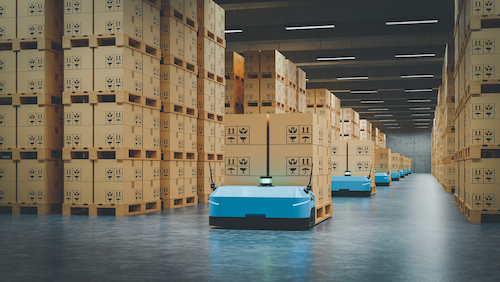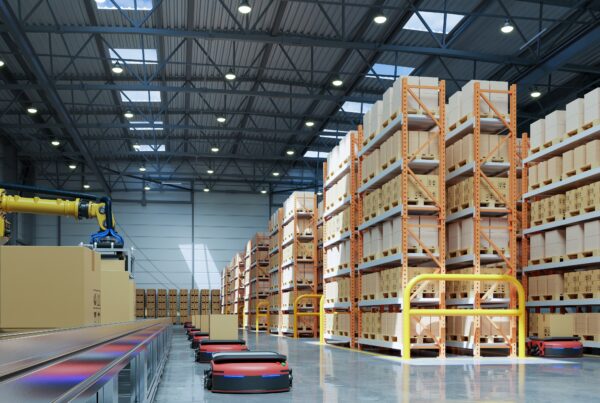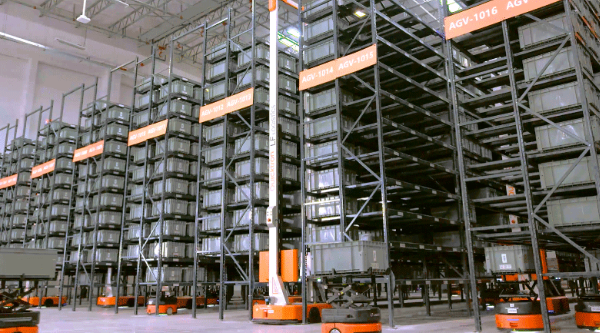As labour expenses continue growing, and no matter higher wages, warehouse managers are having a hard time recruiting, training, maintaining employees, and keeping them safe. As a result, the use of automated warehouse robots has become an appealing choice for companies seeking to grow productivity, decrease costs, remain competitive and increase efficiency.
What are automated warehouse robots?
Automated warehouse robots are a type of industrial robots with specialized software that are designed to perform streamlined and automated warehousing processes. These robots are used in warehouses for various purposes, such as picking and packing, loading and unloading, transporting goods, and replenishing and inventory management.
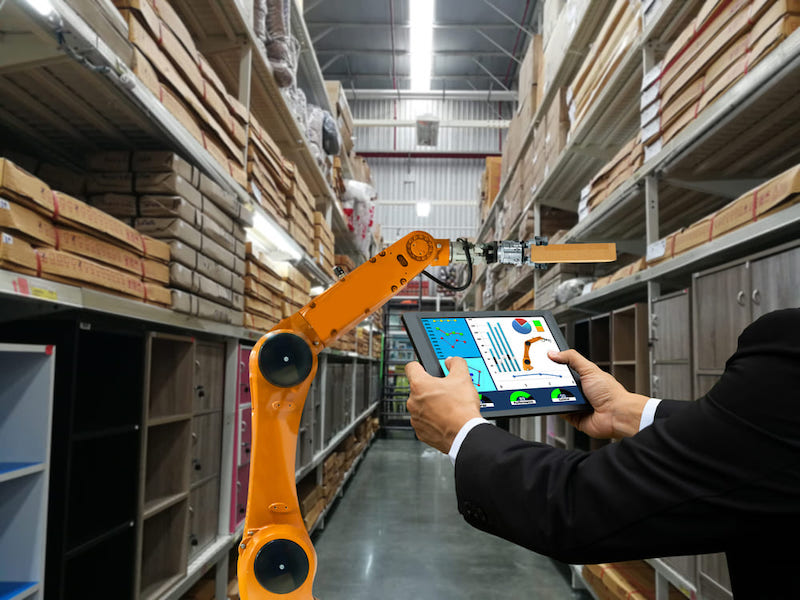
Robots in warehouses can be categorized into two types: mobile robots and stationary robots. Mobile robots have wheels or tracks to move around on the floor of the warehouse while stationary ones stay in one place all the time. Mobile robots are usually more expensive than stationary ones because they need more sensors and controls to operate safely on their own.
In recent years, automated robots in warehouses have been gaining attention in the areas of supply chains, distribution centres, inventory, and warehouse management, as it continues to play an essential part in warehousing automation. Robotics has been advancing towards a takeover of warehousing processes, but with the COVID-19 pandemic, it seems to be speeding up. Previous robots were limited to performing standard tasks such as pallet picking through marked paths. Today, robots in warehouses opened a whole different world in automation.
As the pandemic hit, e-commerce demand went to the roof, and labour intensified, so robots became more a necessity than a luxury. Warehouse managers had to rely more on robotic warehouse automation. Companies have been able to create safer working stations by decreasing employee interactions and increasing productivity that meets e-commerce requests. As of today, the use of warehouse robots automation has reached a new direction and soon each warehouse will use an estimated at least 10 robots in its warehousing processes.
The most popular kinds of automated warehouse robots
Robotic warehouse automation has made warehousing processes more efficient by automating manual or complex tasks. Automation can improve productivity, reduce labour costs, and enhance workers’ safety. Robots will help reduce employees’ long hours of labour, avoiding fatigue and overtime hours. Warehouse automation and robotics solutions are quite varied. Here is a list of the most popular automated warehouse robots:
Voice picking and voice tasking
Workers instruct robots to move and pick up tasks through wireless headsets.
Drones
Drones are mostly used for inventory management. They are equipped with barcode scanners that help inventory counts and inform warehouse workers when there is a need for product restock. Today some companies are implementing the use of drones for deliveries as well.
Robotic arms
The arms can be used at a Goods-to-Person (GTP) workstation for picking, loading empty boxes to conveyor belts, and placing items into a sorter automated machine for outbound shipping belts.
Collaborative Bots (CO-BOTS)
They help to reduce walking time for picking and increase productivity through the picking process.
Mobile Rack Goods-To-Person (GTP) Arms
This robotic warehouse automation delivers products through mobile rack systems to workers’ stations optimizing productivity.
Roaming Shuttle Arms
They are used for the storage and transport of products.
Unit Load Transport Autonomous Mobile Robots (AMR)
These types of automated robots in warehouses are used for putting away merchandise, transporting pallets across long paths, placing empty pallets in their proper aisle, and transporting trash and dunnage.
Advantages and disadvantages of robotic warehouse automation
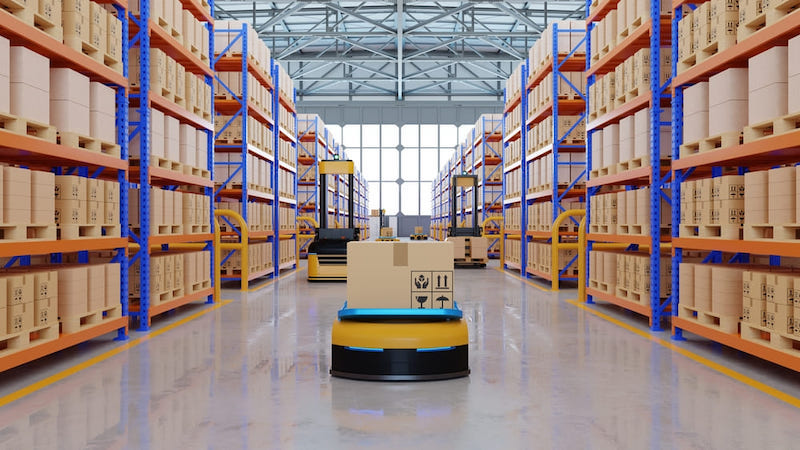
Advantages:
Costs effectiveness
With the use of automated robots in warehouses, there will be no more holidays, sick leaves, or other obstacles to productivity. Robots can be programmed to work in repetitive cycles until set to do otherwise. This will help to reduce labour costs and produce higher benefits for warehouse managers.
High productivity
Robots in warehouses take the place of employees, so these can focus on critical thinking projects that could increase productivity while lower-values and repetitive tasks are done by automated warehouse robots.
Completing routine tasks at a consistent quality and speed
Robotic automation eliminates the risks of human errors by accurately checking that the items meet the required quality standards. Warehouses will be able to increase productivity without affecting quality.
Improved workplace safety
Whether it is to fatigue, overwork, sickness, stress, or other human-related issues, employees are prone to accidents while operating heavy machinery. Using robots will help avoid them by increasing workplace safety and reducing damage to products, equipment, and warehouse structures.
Optimized warehouse space utilization
Robotic warehouse automation can help remove the need for expensive expansion as they don’t require bigger spaces to function in. Robots can accommodate any space than human-operated machinery.
Easier scheduling
Robots can work for long shifts without the need for breaks — a massive difference from your flesh and bones staff members.
Quick implementation
Robots can be implemented in about four to six weeks depending on the needs of the warehouse.
Disadvantages:
High Initial Investment Costs
Robotic deployment can be costly for smaller warehouses. While the benefits of using warehouse automation robots will reduce labour costs and increase productivity, the need for maintenance and programming will come with a high cost.
Maintenance
Routine checkups and repairs will lead to operation downfalls while being conducted.
Hiring Skilled Staff
Skilled staff must be hired to safely handle automated robots; therefore, it could lead to some waste of time while the personnel is being trained.
Potential Job Losses
Robots don’t increase employment in a warehouse, they do the opposite. Workers can be lay-off as robots can do their jobs at a faster, consistent rate and perform more than one task.
No adaptability or ingenuity
Robots are unable to adapt to any change, they can only work for what they were programmed to.
Processes automated robots can improve?
Automated robots in warehouses can improve accuracy and efficiency in the supply chain. In a warehouse, there are many processes that automated robots can enhance. The proper automation can help increase order fulfilment and inventory control. Other processes include:
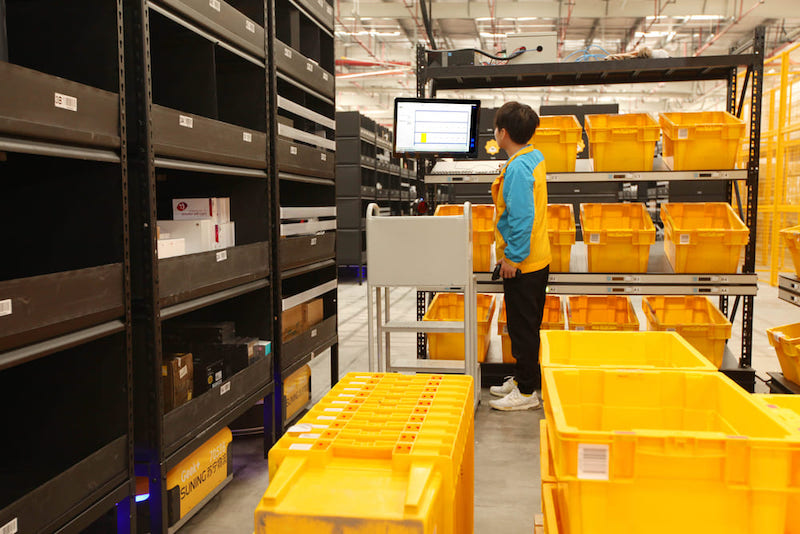
Receiving and dispatch
Product receipt and dispatch processes are sped up with truck loading and unloading automated warehouse robots.
Putaway
Automated robots in warehouses help move products horizontally and vertically in the storage aisles. This process can facilitate cross-docking and make putaway more efficient and accurate.
Picking
Order picking robots improve order processing times by reducing travel time through the warehouse.
Sorting
Automated sortation robots use conveyor belts, arms, cameras, and sensors to enable inventory accuracy, and handling of items by placing them in their right bins or storage area.
Replenishment
Automated warehouse robots reduce stockouts and backorder through automated re-ordering as well as avoid inventory loss.
Packaging
Robots in warehouse logistics use automated packaging and cartonization software that determines the needed carton size for shipping based on the product’s dimensions and material costs.
Transportation
Robotic transportation systems such as monorails, conveyor systems, and automated guided vehicles (AGVs) transport pallets and products around the warehouse, reducing time-consuming processes.
In what fields and industries can be robotic warehouse automation successfully applied?
Robotic warehouse automation is a new technology that is being used in warehouses to automate the process of storing, retrieving, and distributing goods. Robotics can help improve operations in a variety of fields and industries. Industries expected to thrive with automated warehouse robots are healthcare, law enforcement, agriculture and food service, transportation retail, manufacturing, and logistics.
 Skip to main content
Skip to main content
